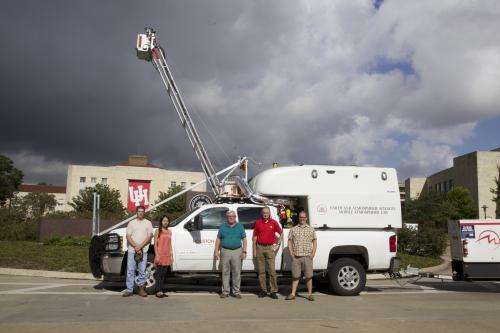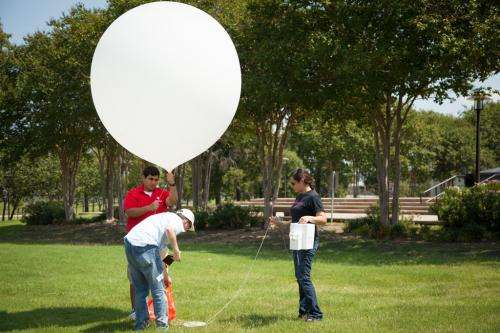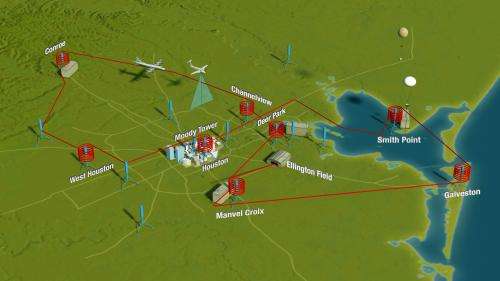Month-long study by UH targets improved air quality forecasting

University of Houston (UH) professors and students are taking part in an air quality study that will help scientists understand how to better interpret and forecast air quality using satellite data and numerical models.
Currently, it's difficult to accurately measure surface air quality based on satellite data, which doesn't adequately distinguish between surface pollution and higher, atmospheric pollution. Ultimately, the project's goal is to help researchers design and build better pollution sensors that could be launched aboard satellites. This, in turn, would result in scientists having a better understanding of how pollution is distributed across large areas, as well as better track its movement.
Throughout September, mobile labs, ground instruments, airplanes and a satellite, took Houston air quality measurements. UH atmospheric scientists Barry Lefer, Robert Talbot and Yunsoo Choi, as well as adjunct professor Gary Morris, worked together alongside 15 undergraduate and graduate UH students. The effort is part of a multi-year NASA air quality study – DISCOVER-AQ – that also includes measurements in Washington, D.C., Baltimore, Los Angeles and Denver.
"Satellites measure the total amount of pollution in the atmosphere, so the readings get the upper level pollutants that don't affect us as much, as well as the lower level pollutants," said Lefer, associate professor in UH's Department of Earth and Atmospheric Sciences. "The trick is how to subtract off the stratosphere to get to the measurements you want."

Scientists collected an enormous amount of data similar to what a satellite measuring air pollution would collect. Two NASA aircraft, equipped with scientific instruments, flew a fixed route over Houston gathering air quality data. Five mobile labs, equipped with similar devices, simultaneously drove approximately the same route. Measurements also were made at stationary locations around Houston and with weather balloons.
Lefer says mobile and stationary measurements, a plane with downward views simulating satellites and a plane getting vertical profiles by spiraling between altitudes will be compared with what a satellite gets for the same day. The satellite measurements come from a fleet of Earth-observing satellites, called the Afternoon Constellation or "A-train," which passes over Houston each day at 1:30 p.m.
"UH has two mobile labs, instrumentation at six of the 15 ground sites and daily weather balloon launches that gather ozone measurements," Lefer said. "We also are hosting several monitoring devices from other universities on our rooftop lab atop the Moody Towers residence hall, as well as in our mobile labs."
Up in the air, one of the NASA planes flew at 26,000 feet, taking downward gaseous and particulate measurements mimicking a satellite. The other plane flew a similar route at lower altitudes and also made spirals around eight locations, sampling the air at various levels over those sites.
"The sampling area covers the Houston metropolitan area, ranging from Conroe in the north to Galveston in the south. The flight path is sort of a figure-eight shape," Lefer said. "The planes flew the route three times each flight day. With 10 to 13 flight days, we're going to have good statistics, with some flights occurring on clean air days and some on dirty days."

UH's Moody Towers residence hall is one of the spiral locations and has instrumentation on its roof that measured everything, and some, that the plane measured. Some of the instrumentation is present at Moody Towers year-round, while other devices housed there belong to visiting scientists from Baylor University, Texas A&M University, University of Colorado, Pennsylvania State University, Appalachian State University, the Environmental Protection Agency, NASA, USDA and NOAA. UH's mobile labs also hold equipment from Chalmers University (Sweden) and Rice University.
At Moody Towers, Talbot's instrumentation measured carbon dioxide, methane and mercury, and Lefer measured ozone, formaldehyde and four other pollutants. Choi's air quality forecasting model helped the NASA project team reach its decision each afternoon on whether to fly the planes the next day. Morris launched weather balloons outfitted with ozone-measuring equipment each day from campus.
"The results of this study are going to help us get a better understanding of what the satellite is showing us," Lefer said. "If we are better able to interpret satellite data, then we can make more accurate air quality analyses and forecasts. And, that will have a big impact on human health."
Provided by University of Houston















